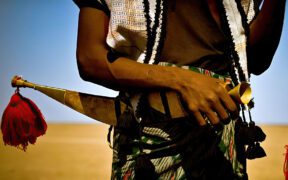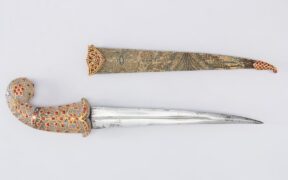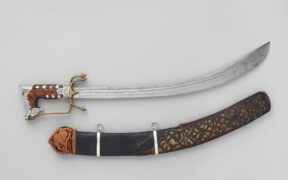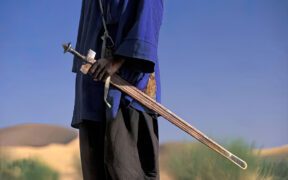Our content features commercial links to our products, committed to transparent, unbiased, and informed editorial recommendations. Learn More
Jambiya: The Traditional Yemeni Dagger
NO AI USED This Article has been written and edited by our team with no help of the AI
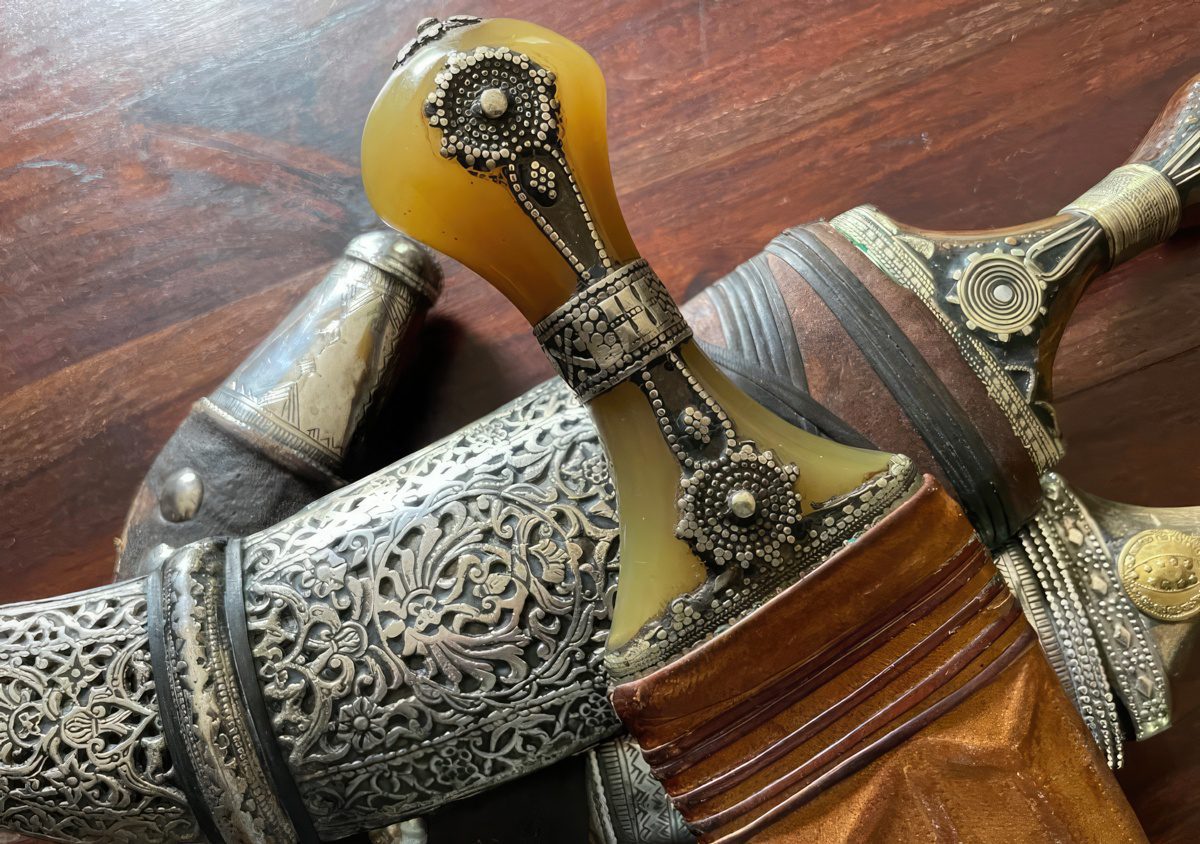
The jambiya is a traditional dagger that is popular throughout the Arab world and is now mostly associated with Yemen, where it remains part of men’s attire. Its design varies according to the region, tribe, and social standing of the owner.
Let’s explore the unique characteristics of the jambiya, why it became a significant part of Yemeni culture, and a few terminologies the locals use.
Types of Yemeni Jambiya Dagger
The jambiya comes in various forms and styles, with the most popular being the ‘aseeb and thumah, both being associated with the northern parts of Yemen. The daggers are generally the same but differ in how they are worn and the scabbard’s form and design.
1. ‘Aseeb
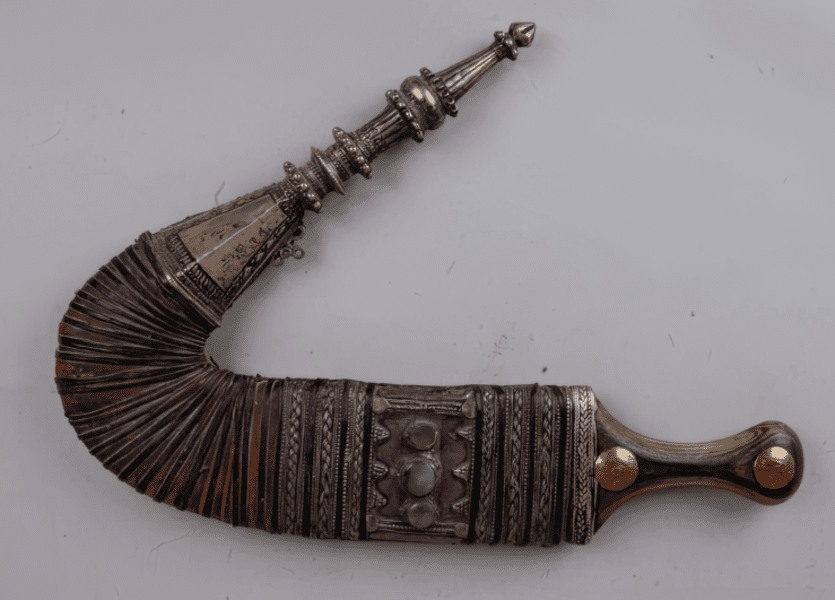
The ‘aseeb, also spelled ‘asib, has a distinctively curved scabbard and is carried upright in front of the body. In the past, it was exclusively worn by tribesmen, but it is now worn by most men in northern Yemen.
The most well-known tribal confederations in Yemen are the Hashid and Bakeel, with the latter wearing scabbards not as strongly curved as the other. While the Hashid scabbard almost points to nine o’clock, the Bakeeli scabbard only points to seven o’clock.
2. Thumah or Tuza
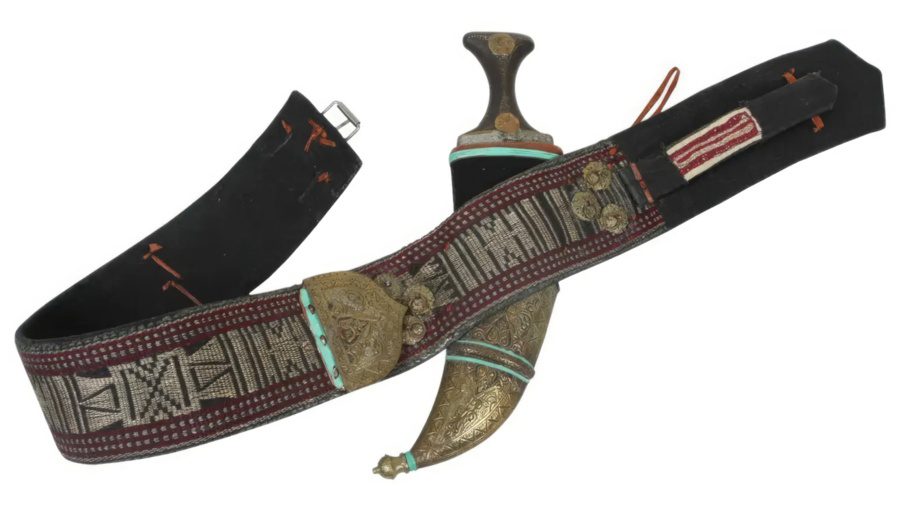
The thumah is worn slanted on the right side of the body. Its scabbard does not curve the same way as the ‘aseeb, but only extends downward in a slightly bent form. Sometimes, the term tuza is used as a synonym for thumah. Before the 1960s, it was restricted to the country’s religious elite.
In northern Yemen, particularly in the Zaydi areas, the religious elites consist of the sada, who were direct descendants of the prophet Muhammad, from among whom came the Imams. Those who had spiritual learning and served as judges, teachers, and the qudha and fuqaha in the administration of the Imam wore the thumah.
Characteristics of the Jambiya Dagger
The jambiya is always curved and double-edged but their hilts and scabbards differ in form depending on the regions they come from.
Here are the unique characteristics of the jambiya dagger:
Metal and Construction
A jambiya blade can be made of steel or iron, produced locally in Yemen or imported from other regions. Generally, a steel blade is less popular than iron because it tarnishes quickly and requires regular polishing. In Yemen, highly valued blades are said to be made from the remnants of tank tracks, and they are lightweight, durable, and resistant to rust.
Another highly manufactured blade type is the joubiyye—named after al-Jawbah district in Maʾrib, where it is produced. The other strong blade is the hadrami iron that comes from the Hadhramaut region. These high-quality blades are often equipped with rhinoceros horn hilts. Today, cheap blades are often machine-made in Sanaa or imported from China.
Blade Appearance
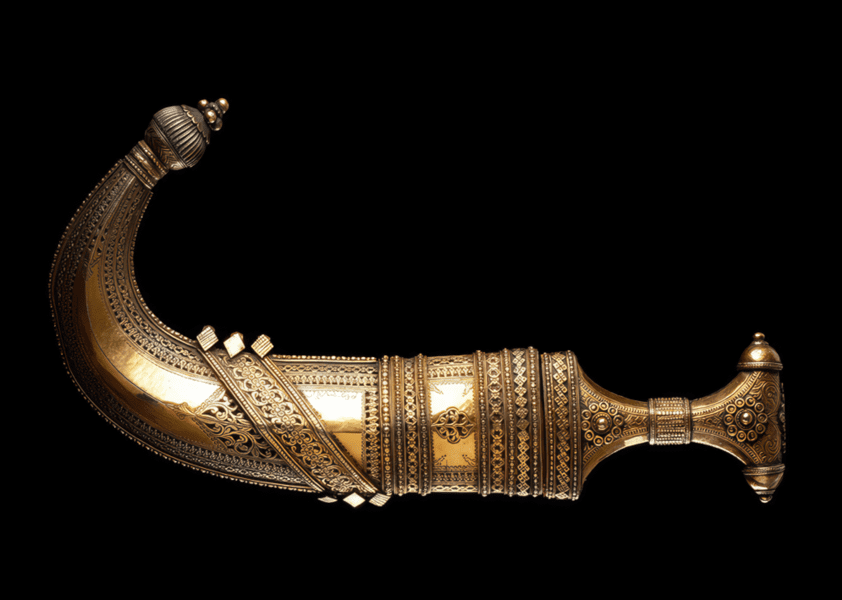
Generally, a jambiya has a double-edged blade bent at various angles. The curved blade gradually tapers toward the tip, with the lower half bending to the side. The blade often has a midrib, some with extra ribs, extending down its entire length to strengthen its structure.
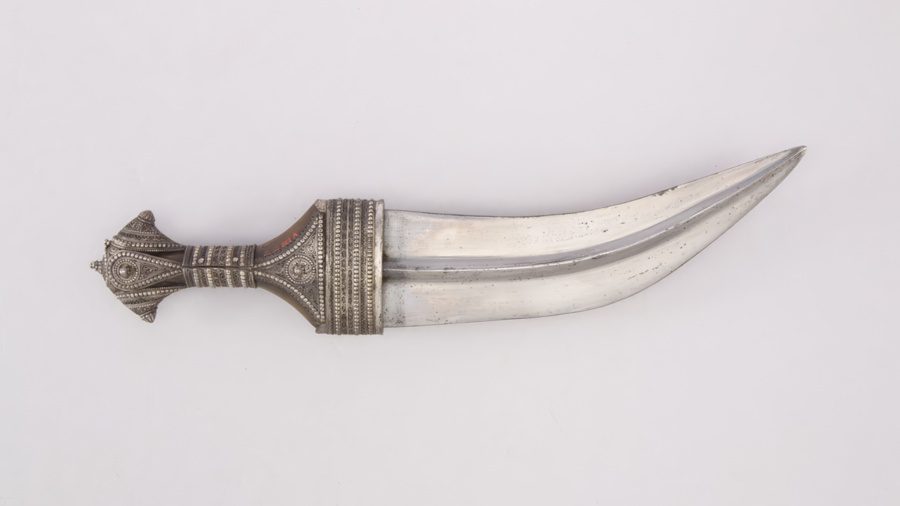
However, jambiya blade shape varies from region to region. In Arabia, blades tend to be shorter, broader, and curved, with pronounced ribs. On the contrary, Moroccan blades tend to be narrower, straighter, and usually lack ribs.
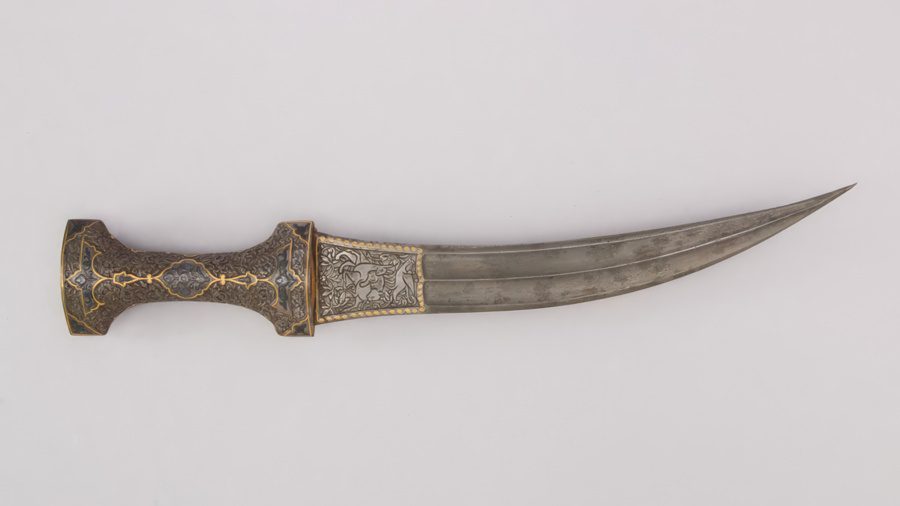
Many jambiya daggers from Persia and India also have the same shape as those from Arab, though they were of finer steel and blade decoration. In combat, the dagger was held with the tip downwards and the curve inward, with attacks focused at the base of the neck.
Length and Width
The jambiya varies in length and width, depending on their origin. It has an overall length ranging from 30 to 35 centimeters (11 to 13 inches) and a blade length of less than 25 centimeters (around 9 inches). At its base, most Yemeni jambiya is typically about 7 to 9 centimeters wide, though others can also be wider or narrower.
Sword Mounting
The jambiya often has an I-shaped hilt and a J-shaped scabbard, though their forms and decoration widely vary in different regions.
Hilt
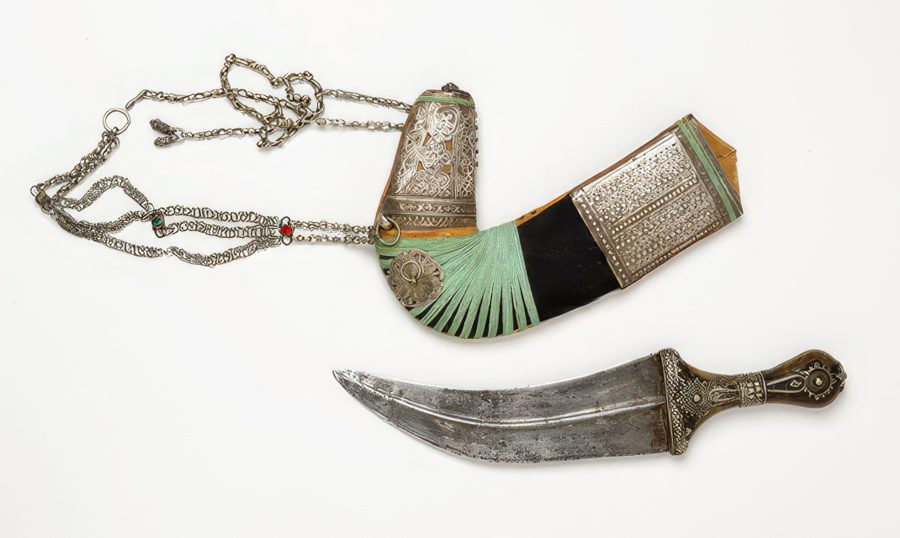
The Yemeni jambiya hilt varies in material, from wood to horn, silver, and gold. A rhino horn is valued for its durability, lightness, and beauty. Some Yemenis also believe that a rhinoceros horn possesses magical or healing properties. Sometimes, the horns of the Arabian oryx are used, as well as goat’s horn and water buffalo’s horn.
On the other hand, silver and gold coating can dent easily, are quite heavy, and require maintenance. Some also use amber, agate, and jasper, though they are too heavy for a hilt and break easily upon impact. In southern Yemen, elephant and walrus ivory are sometimes used, though they tend to crack and discolor quickly.
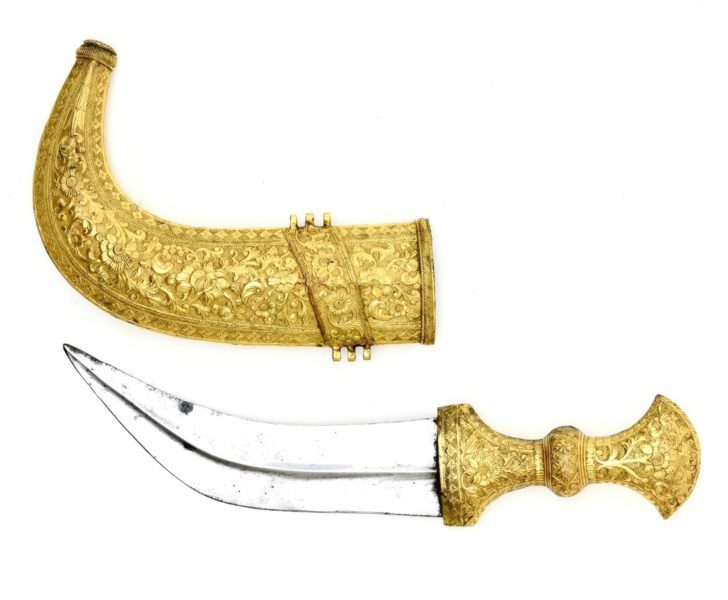
Indian metalworkers also produced jambiya in more Arabic styles, usually for use by the Arabs within the region or for export. An Indian-made jambiya is recognizable for its hilt with a center ball grip, which is typical on Indian chilanum daggers. Also, repoussé metalwork of floral patterns within geometric border designs are common.
Scabbard
The jambiya scabbards vary widely in material, style, and decorations, often indicators of the wearer’s status or tribal affiliations. However, in the Sanaa capital and other urban areas, men often choose their scabbards based on their preferences.
‘Aseeb Scabbard
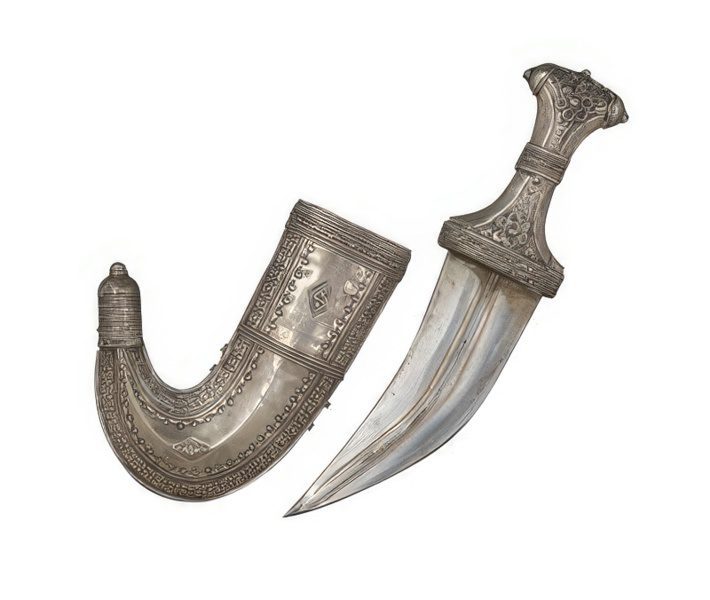
The most inexpensive and commonly seen ‘aseeb scabbards are covered in white or green leather. On the other hand, silver scabbards often indicated the wearer’s high status. In some regions, scabbards are decorated with red agate or red glass, often associated with the Bedouin tribe.
Thumah Scabbard
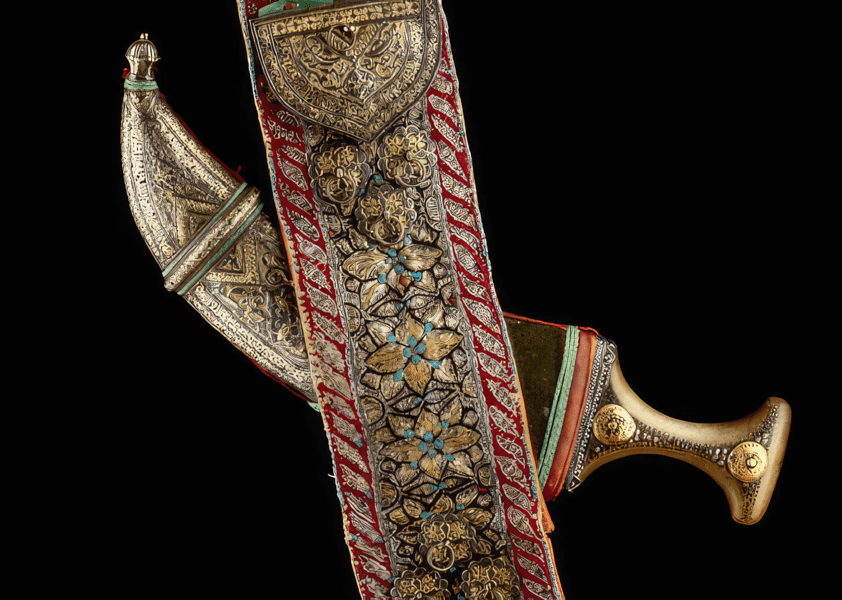
Generally, the thumah scabbard is not as curved as the ‘aseeb scabbard and often ends in a little ball called kawthara. The most valuable type is tuza, decorated with silver or gold. Its quality and silver work may vary depending on the smiths, with the best ones being associated with the Jewish silversmiths of Yemen.
Mecca-Style Jambiya Scabbard
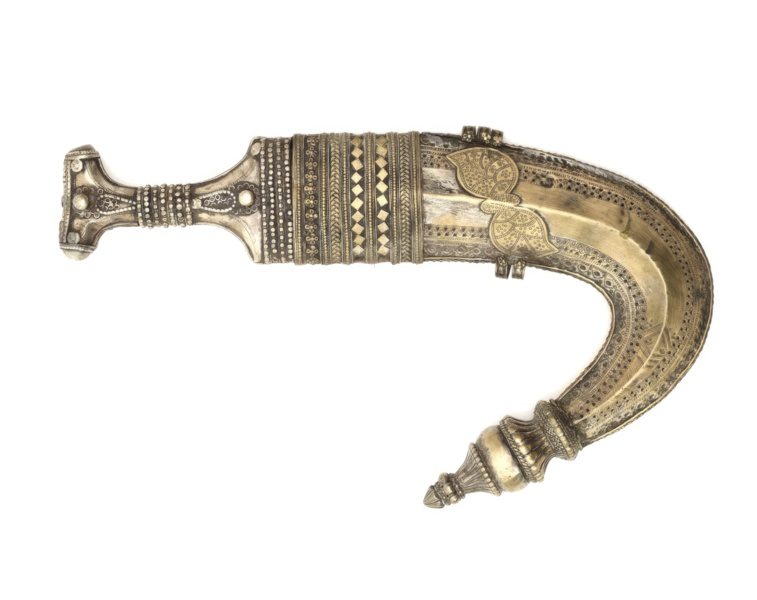
Mecca-style jambiya is often associated with the Muslim pilgrimage. The defining features of its scabbard are a large bud-shaped finial, a diagonal band at the front, and suspension rings. It is also usually decorated with silver wire and beads. Lawrence of Arabia famously wore this style of jambiya dagger.
Dagger Belt (Hizam)
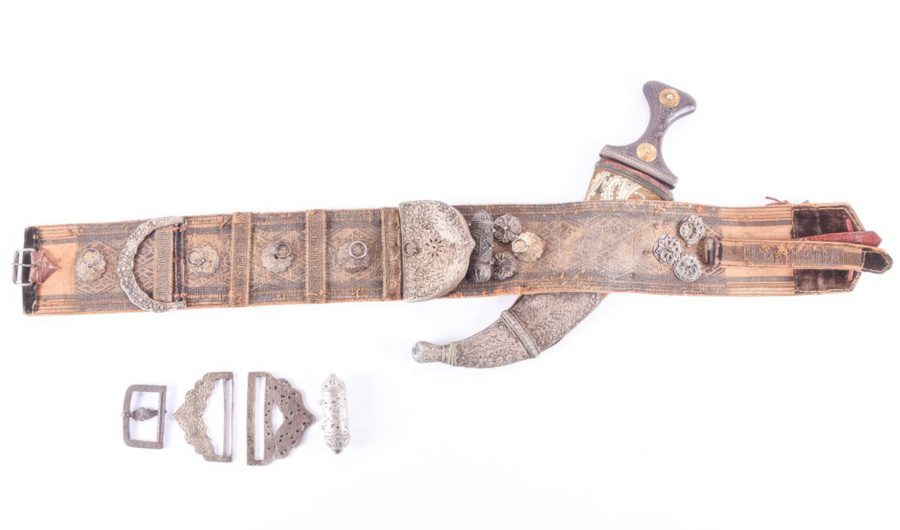
The jambiya comes with its own belt called hizam, which widely varies in style and design. The thumah belt is typically broader, heavier, and decorated with attachments, rarely found on the ‘aseeb belt. These attachments may include a purse, ornamentations, and a document container.
Some well-known embroidered belt designs are called by name, such as the al-Kibsi—named after the tribe in Khawlan. The al-Kibsi belt is often in gold and red colors and is usually worn with a golden thumah.
Facts About the Jambiya Dagger
The men of Yemen continue to wear the jambiya dagger as a symbol of manhood, freedom, and individuality. It is usually worn on the front or right side of the waist.
In Yemen, the word janbiya is pronounced jambiya or gambiya.
Jambiya is the Arabic word for dagger and the most widespread spelling used for the janbiya—the n is turned into an m for ease of pronunciation. The term janbiya comes from the word janb, meaning side, suggesting how the dagger is worn. Its plural form janabi is sometimes used in various sources.
The Yemeni use the term janbiya for any dagger, while the Omani prefer the term khanjar.
The term janbiya is mainly used in western parts of Arabia, including Yemen and Western Saudi Arabia. On the other hand, the term khanjar is used in eastern parts of Arabia, including Oman, the Emirates, and eastern Saudi Arabia, as well as parts of the Hadhramaut region. In middle eastern countries, Iraq and Syria, the term khanjar is also used.
The rhino horn hilts of jambiya are considered more valuable the older they are.
A rhino horn of a jambiya hilt is categorized according to age. A jadeed is a freshly-cut rhino horn, while bint as-souq is not older than five years. On the other hand, malbous is older than five years and has been used. The sayfani is a mature rhinoceros horn, about 50 years of age and older, and has been used.
A sabiki is the large, sword-like variety of the jambiya.
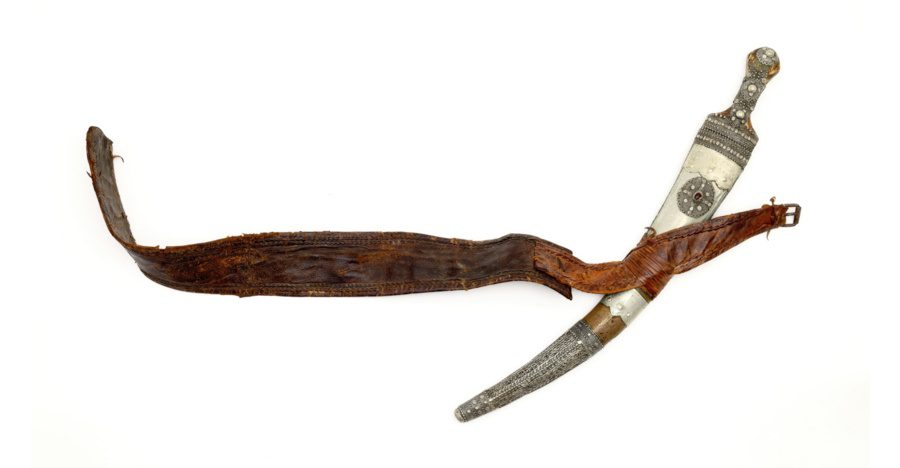
The sabiki, also known as Wahhabite jambiya, was named after the Wahhabi fundamentalists who used them. It is most associated with the Jazan and Asir regions of Saudi Arabia. It remains part of the traditional dress of some tribes of the Khawlan b. Amir confederation. Some Ottoman-made sabiki for the Yemeni market have silver scabbards inlaid with gold.
The Jewish-Yemeni art of silver smithery remains popular in the Arab world.
In Yemen, most silver scabbards of the jambiya are the best works of Jewish silversmiths. The expression ‘amal yuhudi translates as Jewish work, a fine example of silver smithery. The Jewish-Yemeni art of silver smithery is recognized in Yemen, throughout the Middle East, and beyond.
